Table of Contents
Industrial Automation: A Challenging Environment
In a modern factory, machines depend on programmable logic controllers (PLCs) which are ruggedized computers that provide the necessary input and output. These PLCs can be simple in nature, used to automate a single process, or can be highly sophisticated with control over an entire production line.
One of the key challenges faced when installing these increasingly sophisticated devices is protecting them from tough conditions. The factory floor is a demanding environment that can be home to hazardous atmospheres, harsh chemicals, and harmful waste products. Even factories that depend upon sterile environments, such as those in the food preparation and pharmaceutical sectors, use machines that create heat and vibration whilst working. In extreme cases, some industrial processes create a flammable atmosphere in which exposed electrical circuits or unintended sparks might cause an explosion.
Even under these harsh environments, machines depend on both power to operate and the ability to share information with their network. Creating robust and reliable communications requires connectors that can function in these tough conditions, and as automation equipment becomes ever more sophisticated, the number of connections required within the factory will increase.
Connectors play an important role in the life of the factory. Manufacturers need to respond to changes in customer needs and market trends. Providing the greatest flexibility depends on creating a production line that can be reconfigured quickly and easily. To achieve this, many manufacturers use a modular production line in which individual machines can be moved or replaced easily as demands change.
This modular approach also plays a key role in maintenance and repair. A successful production line is one that functions at peak efficiency, which requires a high degree of reliability from its components. If a machine breaks down, a modular production line allows its rapid replacement to minimize delays in manufacturing. In each case, robust connectors provide the means to quickly and efficiently reconfigure or remove machines as needed.
New Trends in Manufacturing: IIoT and Industry 4.0
One of the most exciting developments over recent years has been the Internet of Things (IoT). Most of us have been exposed to the IoT through smartphones. Using handheld technology, consumers can connect to their houses when they are away, control their air conditioning, or even start their cars. These innovations have been enabled by the introduction of fast internet connections, and more recently 5G wireless communication technology which can handle the huge volume of data required by this new functionality. Machines can now use the internet to share information with each other, responding quickly to changing needs and conditions.
 The true potential of the IoT lies outside the consumer market. The factory environment offers opportunities for the Industrial Internet of Things (IIoT), which has resulted in a new revolution known as Industry 4.0. This revolution in how machines can communicate has created the smart factory. A smart factory can be described as a facility where the machines on the factory floor are connected seamlessly to the rest of the business in order to create a single entity. It combines all elements of the manufacturing process, from the initial customer demand to final shipping.
The true potential of the IoT lies outside the consumer market. The factory environment offers opportunities for the Industrial Internet of Things (IIoT), which has resulted in a new revolution known as Industry 4.0. This revolution in how machines can communicate has created the smart factory. A smart factory can be described as a facility where the machines on the factory floor are connected seamlessly to the rest of the business in order to create a single entity. It combines all elements of the manufacturing process, from the initial customer demand to final shipping.
In a traditional factory, even those that embraced automation, all elements of the manufacturing process were separate. Each machine within the production line worked in isolation and the process was managed from a high level. The factory was organised in such a way to be very efficient at one task, but not flexible enough to be able to accommodate changes easily.
The smart factory provides the flexibility that traditional factories cannot. The IIoT allows each machine to collect data about its own function and status, which is then shared with the entire network. Not only does this sharing of information allow the efficient running of the factory, but it also allows any potential problems to be identified so that action can be taken to minimise disruption.
With the advent of the IIoT, all the machines at the device layer are connected, sharing data both with each other and with the upper layers of the business. Therefore, information has become a critical raw material within the smart factory, and it is shared between all layers of the factory.
Making Automation Mobile
The smart factory no longer relies on static machines. Robots have been a common site on many production lines for decades, but recent developments have given them new capabilities. A range of technologies across multiple fields have all matured at the same time to create a new generation of devices known as autonomous mobile robots, or AMRs. At the heart of these AMRs is the processing power of modern microelectronics, but they are nothing without the advances in other areas of technology, from wireless connectivity to batteries and motors.
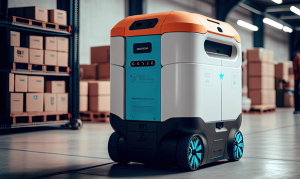 These robots are not self-aware and do not employ true artificial intelligence. However, they are designed to understand the environment around them. Gathering this information, they respond and adapt their actions to accomplish their assigned task. From navigating a busy factory floor to handling sensitive cargo, these robots can act autonomously by employing a form of artificial intelligence known as machine learning (ML).
These robots are not self-aware and do not employ true artificial intelligence. However, they are designed to understand the environment around them. Gathering this information, they respond and adapt their actions to accomplish their assigned task. From navigating a busy factory floor to handling sensitive cargo, these robots can act autonomously by employing a form of artificial intelligence known as machine learning (ML).
The latest generation of AMRs have found applications in a wide range of industries in the real world. There is considerable interest in the deployment of robots into hazardous situations, performing tasks that would be too dangerous for a human worker to attempt. Beyond the factory, examples can be found in scientific research, disaster relief, the vacuum of space, and the challenges of the battlefield. Despite the huge potential for autonomous robots in exotic applications, AMRs have already made a considerable impact in the industrial world.
Autonomous robots are enabling the lights-out factory. A lights-out factory, also called a dark factory, is one where the need for human activity is so small that the facility can operate in the dark. Autonomous mobile robots are an integral part of the production line, employed to deliver raw materials around the factory. The independent nature of these robots allows them to respond to the latest requirements by calculating the optimum route through a complex and dynamic environment. A change in production schedule is automatically communicated to the fleet of delivery robots, ensuring that the right parts are in the right place at the right time.
Topology: Connecting the Layers of the Smart Factory
As the requirements for machines to be part of the smart factory grow, the distinction between machines and network devices is starting to blur. In modern parlance, there is a convergence between the operational technology (OT) in the form of the machines on the factory floor, and the information technology (IT) that controls them. Despite this, the structure of the smart factory is highly organized. Topology is a word familiar to many in the world of computer networking. With the changes being brought about by Industry 4.0, it is also a word being heard in the industrial sector.
The topology or structure of the smart factory is an important factor in its success. The topology of a smart factory is described as a series of layers. At the top is the enterprise or management layer. Contained within this layer are all the systems that administer and control the business, from sales and marketing to logistics and maintenance. It is at this level that the overall running of the organization is conducted.
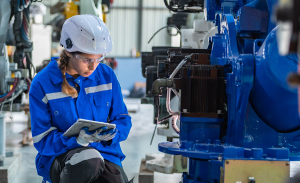 Below the enterprise layer is the control layer. This contains the systems that receive the demands from the enterprise layer and converts them into a work schedule, ensuring that the raw materials are in the right place and that the operators are ready.
Below the enterprise layer is the control layer. This contains the systems that receive the demands from the enterprise layer and converts them into a work schedule, ensuring that the raw materials are in the right place and that the operators are ready.
At the lowest level is the device or field layer. This is the factory floor where all the machines are operated. In a traditional factory before the era of the IIoT, these machines would all have been controlled locally. Skilled operators would ensure that the processes ran smoothly, with little interaction with the rest of the operation. In the modern smart factory, each element of the machinery on the factory floor will form part of the network, carrying information across all the layers of the business.
However, there is a barrier to the fully connected smart factory. The last meter is the name given to the combination of technical challenges involved in making the final connection of a device to the Internet. Unless a factory is brand new, most users are faced with the need to connect existing machinery together and integrate it with the higher layers of the network. Unlike the enterprise and control layers which have been using common computer technologies for many years, the connections between machines often still use industrial bus-type systems.
Connecting Bus Systems
An industrial bus is a communication system that transfers data between components or devices at the different layers in a manufacturing plant. Common systems include Profibus, Fieldbus, and Profinet, which have delivered many years of reliable and rugged service across a wide range of industries. They often use familiar circular connector types, including the popular M8 and M12 connectors. These are part of a large family of cylindrical connectors that use a rotating locking system based on metric threads. They have been extensively used for industrial connectivity and have become a standard for PLCs, sensors, and other control systems. They can be found on a wide range of existing installations.
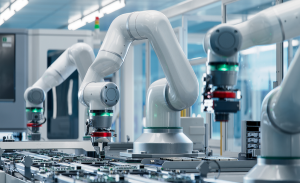 The Bulgin M-Series is an ideal connectivity solution for these industrial automation technologies. Using common industry interfaces, the Bulgin M-series includes circular connectors with M5, M16 & M23 threads, alongside the highly popular M8 and M12 versions.
The Bulgin M-Series is an ideal connectivity solution for these industrial automation technologies. Using common industry interfaces, the Bulgin M-series includes circular connectors with M5, M16 & M23 threads, alongside the highly popular M8 and M12 versions.
Available in panel and cable mounting versions, the Bulgin M-Series also features pre-made overmolded cables up to 15 m in length, along with power and signal distribution units. Bulgin M-Series connectors are suitable for a wide array of industry applications including factory automation, robotics, and manufacturing, along with process control, sensors, and industrial networking.
The M-Series Buccaneer range has been designed to offer flexible connectivity solutions for today’s industrial automation applications. They are available in a choice of metal and plastic variants and are sealed up to IP67, providing the rugged and robust connections that the modern factory needs.
However, it is common for the control and enterprise layers of the smart factory to use conventional Ethernet networks. If the machines on the device or field layer of the smart factory use bus systems, data will need to be translated to communicate with the rest of the network. This adds unwanted complexity into the network, increasing cost and power requirements. In addition, the connectors commonly used in bus systems are not the same as those employed in Ethernet, creating an additional logistical burden when installing new equipment.
Single Pair Ethernet Connectors
A new connector standard has emerged to provide a solution for the last meter and to bridge the gap between the control and device layers. The Single Pair Ethernet (SPE) draws on the extremely common modular connector that is the dominant solution for Ethernet networks. The structured cabling that is the backbone of computer networking has made extensive use of cables with 8 wires arranged in 4 twisted pairs. This basic design has proven hugely adaptable, and even after 2 decades is still used for the latest networks.
In contrast, the principal feature of the SPE connector is its use of just one pair of wires. The SPE protocol seeks to replace the older bus architecture with a unified Ethernet installation using smaller, compact connectors. SPE is not intended to replace the existing Ethernet equipment in the field. There is such an enormous amount of existing infrastructure that supports traditional Ethernet that this would be costly and time consuming for little benefit. Instead, SPE is designed to take Ethernet into places that it was previously unable to reach.
By converting the field level of the smart factory to be an extension of the existing ethernet equipment, it is possible to create a single unified network. Each drive and sensor can be equipped with an SPE connector and given their own unique IP address, creating seamless communication from the machine to the cloud.
Sharing Data from the Floor to the Cloud
Not only does SPE simplify the integration of new devices into an existing network, but it also provides important benefits for the smart factory concept. One of the key requirements of Industry 4.0 is that machines can now provide data to the higher levels of the network. This data can be used to monitor the efficiency of the production process, but it will also provide important information about the status of the machines themselves. This data provided by sensors is a key requirement for the use of digital twins. A digital twin is a virtual model that replicates the functioning of a system up to the complexity of an entire factory. By comparing the real-world data collected with the hypothetical model of the digital twin, any potential faults or inefficiencies can be quickly identified.
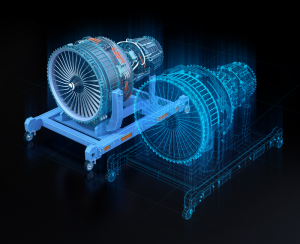 For this monitoring to be effective, the information must be available in real time. Machines that are part of an ethernet network will be able to use the standards created by the IEEE for Time-Sensitive Networking, allowing operators to view the status of the factory on a second-by-second basis.
For this monitoring to be effective, the information must be available in real time. Machines that are part of an ethernet network will be able to use the standards created by the IEEE for Time-Sensitive Networking, allowing operators to view the status of the factory on a second-by-second basis.
Installing new devices is made easier by the power capabilities of the SPE connector. For several years, Power over Ethernet (PoE) has allowed network components to be installed without the need for a separate power supply. Using a variant known as Power over Data Line (PoDL), the SPE connector system can deliver power to devices, removing the need for local power supplies. Using a choice of 12-, 24-, or 48-Volt supplies, the SPE network can provide up to 50 Watts of power to sensors, displays, and indicators. The use of a single twisted pair cable to provide both data and power connections to devices gives the opportunity to save both weight and space.
Selecting Connectors for the Smart Factory
Conventional networking connectors, and even the new SPE standard, are vulnerable to the demanding conditions of the factory floor. Installing automation equipment in harsh environments requires connectors that provide protection and reliability while still providing the high data rates required for modern applications. It is important to understand how to specify connectors that can perform in the factory environment.
Sealing and Robustness
To help designers to choose the right components, manufacturers have adopted the international system known as IP ratings. IP stands for Ingress Protection, and the system provides a shorthand that helps engineers to understand the right choice for their design.
The IP rating is forms of two digits that describe the protection provided. The first digit describes the size of the particles against which protection is provided. The highest rating is 6, which denotes protection against water.
The second digit indicates the level of protection provided. The most frequently used rating for connectors is IP67, which protects against everyday dust and grime. It also provides protection against limited immersion in water. IP67-rated connectors are ideal for outdoor applications that are subjected to wind and rain, such as CCTV cameras mounted to buildings.
However, for installations that require a higher performance, the IP68 rating provides protection against long-term immersion. Equipment destined for the military or agricultural industries provide excellent examples of this type of product.
Recent years have seen increased use of the newer IP69K classification. Products with the IP69K rating are protected against high-pressure spray, such as a those used to wash equipment after use. It has found many applications in the industrial arena, where machinery is subjected to aggressive cleaning processes.
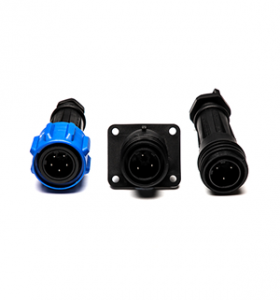 The circular design of the Bulgin Buccaneer series is ideally suited for creating waterproof connectors. The most important area of sealing is between the face of the male and female connectors. In the Buccaneer series, this is achieved with the use of a doughnut-like O-ring that is compressed between the mating connector shells. The screw system used by the Buccaneer allows the user to lock the connectors together. It also provides the force required to compress the O-ring between the male and female connectors to create the watertight seal.
The circular design of the Bulgin Buccaneer series is ideally suited for creating waterproof connectors. The most important area of sealing is between the face of the male and female connectors. In the Buccaneer series, this is achieved with the use of a doughnut-like O-ring that is compressed between the mating connector shells. The screw system used by the Buccaneer allows the user to lock the connectors together. It also provides the force required to compress the O-ring between the male and female connectors to create the watertight seal.
The cylindrical shape of the Buccaneer is also ideal for preventing water ingress around the cable entry. As most cables are circular in cross-section, a simple rubber gland can be used, and the rear of the connector compresses the gland onto the cable to create a conformal seal.
For applications that require a fixed connector, the Buccaneer offers a range of panel-mounting options. These include a gasket that provides a seal around the connector to maintain the watertight integrity of the panel or enclosure. It is important to remember that connectors such as the Buccaneer series are usually only sealed when mated. For situations that require connectors to be left unplugged, the Buccaneer series offers a range of caps that ensure the connectors will be fully sealed, even if not needed. The caps use the same O-ring technology as the mating connectors, providing the same IP68 protection even in tough conditions.
Choosing Materials for Automation Connectors
The choice of material from which a connector is made is key when selecting the right solution for any application. The shell of the connector provides mechanical, environmental, and electrical protection for the circuits within. The shell material plays an important role in determining its performance.
Connectors that are destined for harsh environments must be designed from the outset to withstand the conditions of their service. It is even more important in these conditions to choose materials that deliver the right combination of qualities.
Buccaneer circular connectors are designed to provide superior protection for electrical circuits in harsh environments, and Bulgin has taken great care to ensure that the shell material delivers the performance needed for service in these conditions.
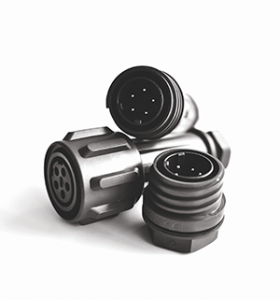 Most members of the original Buccaneer family employ outer shells moulded from Polyamide, a material that provides high strength and durability. Combined with the cylindrical design of the Buccaneer, Polyamide results in very strong connectors suitable for use in a wide range of industries.
Most members of the original Buccaneer family employ outer shells moulded from Polyamide, a material that provides high strength and durability. Combined with the cylindrical design of the Buccaneer, Polyamide results in very strong connectors suitable for use in a wide range of industries.
Other members of the Buccaneer family use different materials. The new 9000 series is designed for high-current power applications up to 225 Amps. The shell of the connector is manufactured from Delrin, a material known for its hard-wearing characteristics. It also offers excellent stability even at low temperatures.
The EXPlora range of circular connectors is designed to be intrinsically safe for use in hazardous or explosive atmospheres. The EXPlora range uses shells manufactured from flame-retardant Polyester to protect against the possibility of ignition and to provide superior electrical isolation.
Delivering High Performance
Even with the growth of 5G wireless communication, all devices need a combination of power and data connection, from the largest machine to the smallest sensor. The connectors designed for these roles must deliver high reliability even in the tough conditions of the factory. At the same time, the increased speed and volume of data traffic means that high-performance connectors will become more important than ever, even in the world of wireless communications.
This need to process high volumes of data means that sophisticated computing and networking devices are being deployed into the demanding conditions of the factory floor. Conventional data connectors are not designed for use in these harsh environments, and so designers need solutions that can provide secure communication even in tough conditions.
The Buccaneer series has been providing sealed, waterproof connections for the world of industry for decades. Bulgin has taken the features that make the Buccaneer so successful for power and signal applications and created the Buccaneer for Data family of connectors.
Buccaneer data connectors combine the sealing technology that has been perfected over the years with the connector interfaces that are commonly used in networking and computing. The Buccaneer family includes solutions for the full-sized RJ45 networking connector in the Standard and 400 Series, the USB-C connector in the Data series, and the latest T1 SPE interface housed in the highly capable 4000 series shell. Combined with their robust design and sealing to IP68 and IP69K, the Buccaneer networking connectors offer solutions for all of the latest factory automation applications.
An additional benefit of Bulgin’s approach to data connectors is that they interface easily with existing conventional cables used in protected. This can be useful in maintenance and troubleshooting situations, allowing the device to be repaired in the shelter of the workshop without the use of special connectors.
Bulgin: Experts in Automation Connectors
Having refined the Buccaneer family of connectors over many decades, Bulgin has established itself as a market leader in harsh environment products. To maintain the high levels of performance and service, Bulgin has embraced the latest technology.
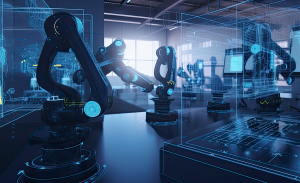 Bulgin’s in-house team develops both standard and custom products using the latest in computer aided design. The use of 3D design and rendering provides clear communication with customers at all stages of the process, while at the same time enabling the easy transition between design and manufacture. Advanced techniques including simulation and finite element analysis ensures that designs are mature, even before parts are manufactured. When the time comes to produce evaluation samples, the latest rapid prototyping techniques allow Bulgin to deliver parts quickly, reducing the delays caused when adopting new products.
Bulgin’s in-house team develops both standard and custom products using the latest in computer aided design. The use of 3D design and rendering provides clear communication with customers at all stages of the process, while at the same time enabling the easy transition between design and manufacture. Advanced techniques including simulation and finite element analysis ensures that designs are mature, even before parts are manufactured. When the time comes to produce evaluation samples, the latest rapid prototyping techniques allow Bulgin to deliver parts quickly, reducing the delays caused when adopting new products.
The manufacturing processes, including moulding, machining and plating, are fully controlled by Bulgin’s vertically integrated structure. This expertise goes beyond the manufacturing of components. In-house capabilities in electronic circuit design, overmoulding and cable assembly allows Bulgin to provide everything from a single connector to a fully realized, turnkey solution for customers with complex demands.
The combination of world-class in-house experience with the latest in prototyping and manufacturing techniques makes Bulgin an excellent partner for developing new connectivity products. With nearly a century of experience in solving electrical problems in harsh environments, Bulgin is the ideal partner to deliver the sealed connectivity system for the latest factory automation equipment.
